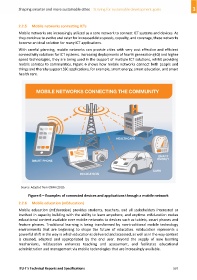Page 607 - Shaping smarter and more sustainable cities - Striving for sustainable development goals
P. 607
2.2.5 Mobile networks connecting ICTs
Mobile networks are increasingly utilized as a core network to connect ICT systems and devices. As
they continue to evolve and cater for increased data speeds, capacity, and coverage, these networks
become an ideal solution for many ICT applications.
With careful planning, mobile networks can provide cities with very cost effective and efficient
connectivity solutions for ICT systems. Increasing deployments of fourth generation (4G) and higher
speed technologies, they are being used in the support of multiple ICT solutions, whilst providing
mobile services to communities. Figure 6 shows how mobile networks connect both people and
things and thereby support SSC applications, for example, smart energy, smart education, and smart
health care.
Source: Adapted from GSMA (2013).
Figure 6 – Examples of connected devices and applications through a mobile network
2.2.6 Mobile education (mEducation)
Mobile education (mEducation) provides students, teachers, and all stakeholders interested or
involved in capacity building with the ability to learn anywhere, and anytime. mEducation makes
educational content available over mobile networks to devices such as tablets, smart phones and
feature phones. Traditional learning is being transformed by non‐traditional mobile technology
environments that are beginning to shape the future of education. mEducation represents a
powerful shift in the way in which education is delivered and accessed, as well as in the way content
is created, adapted and appropriated by the end user. Beyond the supply of new learning
mechanisms, mEducation enhances teaching and assessment, and facilitates educational
administration and management via mobile technologies that are increasingly available.
ITU‐T's Technical Reports and Specifications 597

